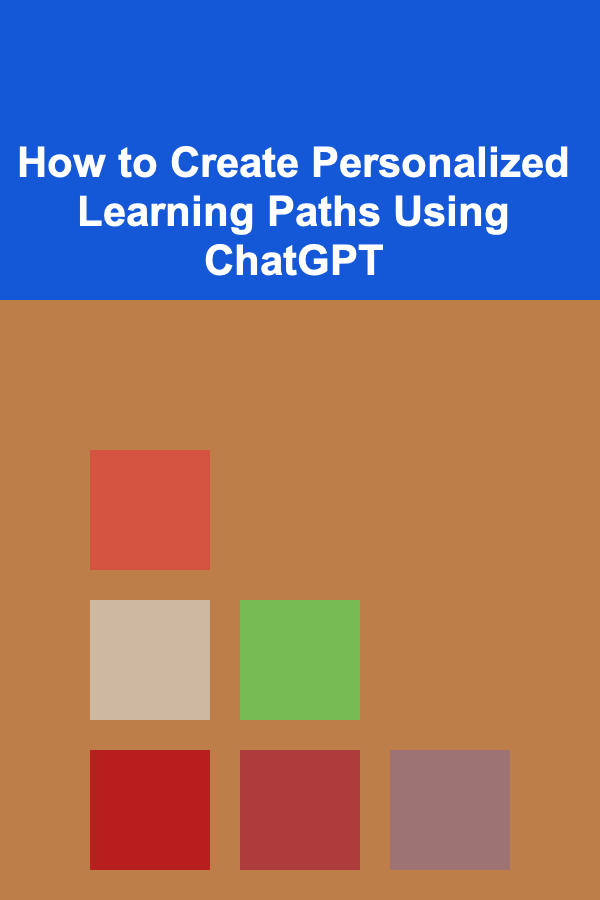
How to Create Personalized Learning Paths Using ChatGPT
ebook include PDF & Audio bundle (Micro Guide)
$12.99$8.99
Limited Time Offer! Order within the next:

In the ever-evolving world of education, the ability to create personalized learning paths has become a crucial component of effective teaching. One of the most innovative ways to achieve this is through Artificial Intelligence (AI), specifically models like ChatGPT, which provide the potential to tailor learning experiences based on individual needs, interests, and pace. ChatGPT, developed by OpenAI, can interact with students, understand their progress, and offer recommendations, making it a versatile tool for personalized education.
In this article, we will explore how educators, learners, and institutions can harness ChatGPT to design personalized learning paths. From creating customized learning materials to adjusting content based on real-time feedback, we will discuss the various strategies to integrate ChatGPT into personalized learning and why this approach can revolutionize the way students learn.
The Importance of Personalized Learning Paths
Personalized learning refers to a tailored educational approach where the content, pace, and style of learning are adjusted to fit the individual needs of each student. Unlike traditional, one-size-fits-all educational systems, personalized learning seeks to cater to the unique strengths, weaknesses, and learning preferences of each learner.
Several benefits of personalized learning paths include:
- Improved Engagement: Students are more likely to remain engaged when the content is relevant to their interests or fits their learning style.
- Greater Retention: Personalized approaches often lead to better understanding and retention of material, as students are learning at their own pace.
- Targeted Support: Personalized learning allows educators to provide targeted interventions, helping students who may need additional support.
- Enhanced Motivation: Students are more motivated when they feel that the content is tailored to their needs, and they can progress at a comfortable speed.
By leveraging AI models like ChatGPT, the process of creating and maintaining these learning paths becomes significantly more accessible and scalable. The adaptability of ChatGPT makes it a powerful ally for both learners and educators looking to customize their educational journeys.
How ChatGPT Can Help Create Personalized Learning Paths
ChatGPT, with its conversational abilities and vast knowledge base, can assist in creating personalized learning paths in several key ways. Here's how:
1. Assessing the Student's Needs and Learning Style
The first step in creating a personalized learning path is understanding the learner's individual needs. ChatGPT can serve as an intelligent diagnostic tool by asking a series of questions that assess the student's prior knowledge, learning preferences, and areas of interest. This can be done through an interactive conversation, where the AI asks the learner to reflect on their strengths and weaknesses.
For example, ChatGPT can start by inquiring about a student's familiarity with a subject, whether they prefer theoretical explanations or practical examples, and if they have any specific goals or projects in mind. Based on the responses, the AI can categorize the student's proficiency level and suggest content that aligns with their current understanding, ensuring that the learning path is not too challenging or too simple.
2. Designing Dynamic Learning Materials
Once the learner's needs are assessed, ChatGPT can begin generating personalized learning content. This content can take various forms, including:
- Curated Reading Lists: Based on the student's interests and proficiency, ChatGPT can recommend articles, textbooks, or research papers that are tailored to their level of understanding.
- Interactive Exercises: To reinforce concepts, ChatGPT can generate quizzes, problems, or case studies that align with the learner's current topic of study. These exercises can adapt in difficulty as the student progresses.
- Multimedia Resources: ChatGPT can suggest video lectures, podcasts, or interactive simulations that complement the written materials and provide alternative ways of engaging with the content.
The dynamic nature of ChatGPT means that the content can evolve in real time as the student progresses. For instance, if a student finds a certain topic particularly challenging, ChatGPT can provide additional resources, such as beginner-level explanations or visual aids, until the student is ready to move on.
3. Adaptive Feedback and Progress Monitoring
One of the key advantages of using ChatGPT in personalized learning is its ability to provide adaptive feedback. As students engage with the materials and complete exercises, ChatGPT can track their progress, identify areas where they may be struggling, and offer real-time feedback.
- Immediate Corrections: If a student answers a quiz question incorrectly, ChatGPT can immediately offer a correction, explain the concept in more detail, and provide additional examples for clarification.
- Motivational Support: Personalized learning can sometimes lead to frustration, especially if students feel they are falling behind. ChatGPT can offer words of encouragement, remind students of their achievements, and suggest strategies to overcome learning obstacles.
- Detailed Analytics: For educators, ChatGPT can provide a detailed report of a student's progress, highlighting areas of strength and topics that require more attention. This allows teachers to adjust the learning path further based on the real-time data provided by ChatGPT.
4. Customizing Learning Pace
One of the most significant benefits of ChatGPT is its ability to cater to different learning speeds. Some students may grasp new concepts quickly, while others may need more time to absorb information. ChatGPT can adjust the pace of the learning materials to fit the student's progress.
- Flexible Timelines: Students can choose their own pace of learning, setting deadlines for themselves, or leaving it up to ChatGPT to recommend when to move on based on the completion and understanding of tasks.
- Continuous Learning Paths: The AI model can build upon previous lessons, ensuring that the learning journey is continuous and cumulative, which prevents gaps in knowledge from developing.
The ability to learn at one's own pace helps students retain more information and reduces stress or burnout associated with the rigid timelines of traditional classroom settings.
5. Integrating Gamification and Interactive Learning
ChatGPT can also integrate gamification elements into the learning path. By turning learning into a more interactive and fun experience, ChatGPT can motivate students to engage with the material more deeply. Some of the gamification features that can be integrated into personalized learning paths include:
- Achievement Badges: Students can earn badges for completing lessons, reaching milestones, or mastering a specific skill. These rewards can be tied to the student's individual learning goals, offering them a sense of accomplishment.
- Points and Leaderboards: To introduce friendly competition, ChatGPT can assign points for completed tasks and track progress over time. This feature can be particularly useful in group learning environments.
- Challenges and Levels: ChatGPT can set up a system of levels, where each new level introduces more advanced material. Students can unlock new content as they progress, creating an element of discovery and accomplishment.
6. Fostering Collaborative Learning
ChatGPT is not only effective for individual learning but can also be used to foster collaborative learning environments. It can create personalized group learning paths where students collaborate on tasks, share insights, and work on joint projects.
- Group Challenges: ChatGPT can generate group challenges that require collective problem-solving, fostering teamwork and peer-to-peer learning.
- Discussion Prompts: ChatGPT can suggest topics for group discussions or debates, based on the learners' interests, to promote critical thinking and communication skills.
- Real-Time Collaboration: In group projects, ChatGPT can help coordinate tasks, track individual contributions, and ensure that all group members are on the same page.
Collaborative learning enhances the social aspect of education, helping students develop soft skills like communication, problem-solving, and teamwork.
Challenges and Considerations in Using ChatGPT for Personalized Learning
While ChatGPT presents many opportunities for personalized learning, there are several challenges and considerations to keep in mind:
1. Data Privacy and Security
Given that ChatGPT interacts with learners on an individual level, data privacy is a critical concern. Educational institutions and users must ensure that personal data is protected, and any data collected by ChatGPT complies with privacy laws and regulations like FERPA or GDPR. Sensitive student information, such as learning progress and performance, must be stored securely.
2. Content Accuracy and Quality
While ChatGPT can generate a vast array of educational content, there is a need for careful oversight to ensure the quality and accuracy of the information. Educators should review the materials provided by ChatGPT to make sure they are aligned with academic standards and correct any inaccuracies that might arise.
3. Over-Reliance on AI
Another concern is the potential over-reliance on AI tools like ChatGPT. While the model can enhance learning, it should not replace human educators or the social aspects of learning. Teachers remain essential in providing context, emotional support, and nuanced insights that AI cannot replicate.
4. Bias and Fairness
AI models like ChatGPT are trained on large datasets and may unintentionally reflect the biases inherent in those datasets. Educators must be vigilant in monitoring the materials provided to ensure that they are fair, inclusive, and free from bias.
Conclusion
Creating personalized learning paths using ChatGPT has the potential to transform education by offering tailored, engaging, and adaptive learning experiences for every student. By leveraging AI to assess needs, design learning materials, provide real-time feedback, and adjust content based on progress, educators can create a dynamic and individualized learning environment.
As AI continues to evolve, the integration of tools like ChatGPT into personalized learning paths will undoubtedly become more sophisticated, further enhancing the ability to cater to the unique needs of each learner. However, the success of this approach will depend on careful implementation, ongoing evaluation, and the balance between technology and human interaction. By embracing the possibilities of AI while maintaining a focus on quality education, we can ensure that personalized learning paths become a core element of the future of education.

How to Create a Checklist for Collaborating with Influencers on Social Media
Read More
How to Improve Your Credit Score in 6 Months or Less
Read More
How to Maintain Your Home's Fence to Ensure Long-Term Durability
Read More
How to Manage Your Online Subscriptions Efficiently
Read More
How to Store Items in Plain Sight with Style
Read More
Smart Tips for Saving Money on Transportation Without Compromising Convenience
Read MoreOther Products

How to Create a Checklist for Collaborating with Influencers on Social Media
Read More
How to Improve Your Credit Score in 6 Months or Less
Read More
How to Maintain Your Home's Fence to Ensure Long-Term Durability
Read More
How to Manage Your Online Subscriptions Efficiently
Read More
How to Store Items in Plain Sight with Style
Read More